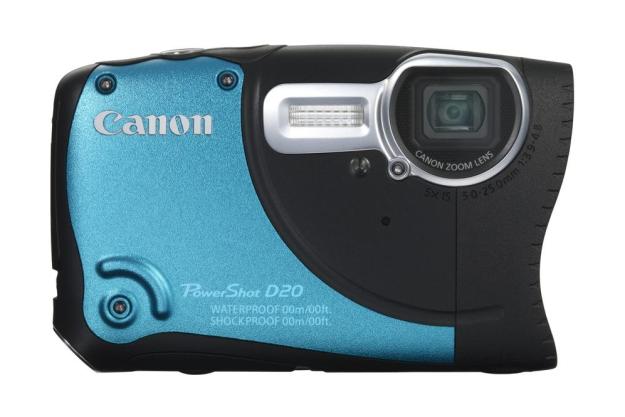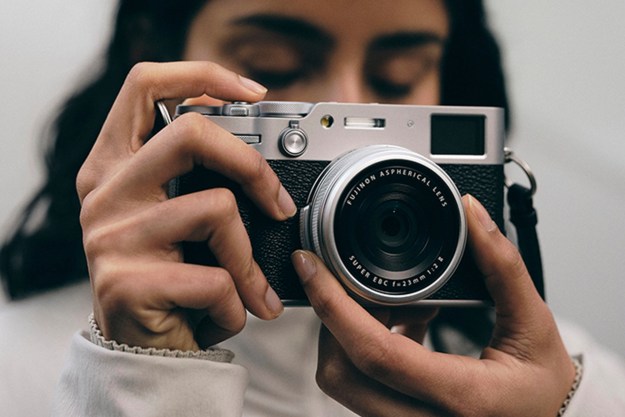
“From the unconventional design to its remarkable lens, this rugged cam easily sits among the best in the bunch.”
- Great in-camera interface
- Sharp lens
- Impressive underwater performance
- Moderately slow; not suitable for fast-action shots or video
- Unconventional design is interesting but bulky
- Unreliable GPS
Canon has taken its time released the next iteration of the rugged cam. The D10 came out in 2009, and its upgrade is now available in the D20. This unusual-looking camera definitely injects some new style into the rugged cam market while also keeping its simple-to-master Canon UI. While the D20 isn’t breaking many barriers here, it does combine a few key elements to steal a good portion of the tough-cam spotlight.
Video review
Look and feel
The Canon D20’s design is unconventional to say that least. From the teal faceplate and buttons to its curvy chassis, this thing doesn’t look like your average tough cam – or point and shoot for that matter. We’re fairly torn about its looks: On one hand, Canon gets points for originality, and it’s far sleeker-looking than most rugged cams. The moniker seems to make manufacturers think their cameras have to somehow look “tough,” and they come out bulky and ugly for the most part. But that’s setting the bar pretty low. Most of Canon’s point and shoots have a really nice minimalism, especially its Elph HS lineup, and the D20 definitely isn’t going to fit in there.
Of course rugged cams are bulky by nature. The nontraditional build to the D20 highlights this, as does the wristband accessory. It attaches at the corner of the camera, which does make it easier to take the wristband on and off, but is still an odd choice.

Despite its heft, the D20 feels good in your hand, and is pretty comfortable to hold with one hand thanks to a small but useable grip on its back. The power, shutter, and playback buttons are all on top of the camera, although only the shutter slightly protrudes from the surface.
The button setup is pretty standout for a point and shoot: You will mostly rely on the “function set,” auto and camera buttons for determining settings. There’s a dedicated video-recording button as well.
One of the strangest design choices is the zoom. Instead of a toggle of some sort, you have a button for zooming in and a separate one for zooming out. It’s yet another unconventional approach in the D20.
Overall, it’s a fairly good-looking, if odd camera. It’s probably a pretty polarizing choice that some people would love and others hate, but compared most rugged cams, this thing is a beauty.
What’s in the box
In addition to the camera, you get the battery pack, battery charger, wrist strap and strap mount accessory, USB cable, and complementary software.
Features
Obviously, the D20 boasts some everything-proof features: It’s waterproof up to 33 feet, shockproof up to 5 feet, and freezeproof up to 14 degrees Fahrenheit. That’s all fairly comparable with other tough cams in this price range.

So what else does Canon throw in to make the D20 a convincing purchase? For starters, it’s GPS capable. This is a function more and more manufacturers are experimenting with, and there have been mixed results. Location metadata isn’t very interesting when you just throw it up on a grid, so camera-makers are trying to make that more interesting. The D20 captures latitude, longitude, and elevation, and you can create a log of this data in addition to just saving it with every photo. Canon also has software that couples with this data to plot pictures on a map, which is more than most GPS-capable camera do. Of course, it’s a battery killer. Worth noting: GPS doesn’t work underwater.
Canon also packs a punch with built-in filters and presets, including all the usual fare like toy camera, fisheye, and miniature, all well as settings for snow, fireworks, and low light. The provided presets probably aren’t as comprehensive as some (settings like “pets,” “food,” and “baby” are becoming increasingly common – and to a certain degree, increasingly ridiculous) but you’ll easily be able to exercise some creativity here. There are, of course, auto and manual settings as well, and you can manipulate exposure, ISO, and color hue incredibly easily.

As far as specs go, the D20 sports a 12.1-megapixel CMOS high sensitivity sensor — which helps out with low-light settings — and uses the Digic 4 processor. This is a downgrade from the Digic 5, which newer Canon point and shoots are sporting – and you can tell (we’ll get to that later). The D20 also boasts an impressively sharp 28mm wide-angle lens, making it great for outdoor, landscape shooting. The 5x optical zoom is pretty standard for this type of camera, and it’s operable during video recording, which is nice.
Performance and use
There isn’t much to say about shooting with the D20 that we don’t say about shooting with nearly every Canon point and shoot: The build is (generally) nice, the in-camera navigation is incredibly easy to master, and new users can rely on auto and presets, or easily warm up to the manual settings. So instead of a thorough analysis of every feature, we’ll highlight the best and worst parts of the D20 experience.
Starting with the good, we were impressed by how far you could push ISO with the D20. It’s not like Canon’s busting out new sensor tech with this model, but it can actually sustain the max 3,200 Canon says it does. Now, you won’t want to blow those photos up very large at all – a 5 x 7 is probably as far as you can go without things getting overly grainy – but for a tough cam, this is pretty impressive. For best results, we’d suggest shooting around ISO 800, where we saw little to no noise, and details stayed crisp.

Shooting underwater is one of the main reasons anyone buys a tough cam in the first place, and the D20 delivers fantastic submerged shots. Many first-gen rugged point and shoots were victim to the dreaded fuzzy halo around underwater pictures, and this is far from the case with the D20. Underwater images are clear, and underwater macro mode also stood up to the test admirably. It would be great if there were some manual settings included for underwater photography, since this is a tough cam’s big selling point, but for the price, you wouldn’t expect it in the D20. Long story short, Canon really did a good job selecting a lens for this application, and coupling it with a 12.1-megapixel sensor that performs pretty admirably in low light.
On to the underwhelming, starting with the D20’s speed. The new Digic 5 processor makes a big difference in what Canon cams are capable of, and only after using a camera with the newer chip do you notice the Digic 4’s shortcomings. Now, the D20 isn’t exactly slow, it’s just not fast – and some people buying rugged cams also want to use them as action cameras and camcorders. The D20 will work, but it’s settling: You can only shoot full 1080p HD at 24 fps, and startup time, recycle time, and shutter lag will hold you back when it comes to taking quick stills. For all other uses, this is such a minimal amount of time that general still shooting won’t suffer.

The other problem we had with the D20 was GPS. We’ve said it before and we’ll say it again: Until camera manufacturers can figure out something interesting to do with this feature, make it work consistently, and not have it suck battery like it currently does, we’re just not on board. Canon does a better job than most by including software that plots your photos along Google Maps, but that’s still sort of underwhelming. And too many times, the feature didn’t even work. We would often turn on GPS and the GPS logger (which sucks your battery even when the camera isn’t on), and get an icon telling us it couldn’t find our location. None of the photos we took in this state were tagged with GPS data, and we took them all outdoors in downtown Portland with a clear view of the sky. GPS is part of what makes these cameras more expensive, but if it only works part of the time, you’re not going to be making good use of it.
Like we mentioned, the D20 won’t be able to do much in the way of action shooting, which also applies to video. You can only shoot full HD at 24 fps, so anything very action-oriented is out of the question. That said, the zoom is operable during video recording and it performs decently underwater.
Conclusion
Tough cams are an experimental breed by nature, and Canon pulled out the stops with the D20. From the unconventional design to its remarkable lens, this rugged cam easily sits among the best in the bunch. The fact that it shoots superbly underwater will be enough to sell many interested buyers, as should its incredibly easy-to-master UI. Though the D20 won’t woo action shooters and the price might make you a little standoffish, it’s an incredibly competitive camera.
Canon’s going to face some competition from the Olympus Tough TG-1, which is trying to sophisticate the tough cam market a bit with features like an f/2 lens – and it only costs $50 more than the D20. But the Canon model is more compact, and has Canon’s polished in-camera UI that will win over anyone familiar with the manufacturer.
Best buy for: Travelers, vacation camera buyers, underwater photography
Highs
- Great in-camera interface
- Sharp lens
- Impressive underwater performance
Lows
- Moderately slow; not suitable for fast-action shots or video
- Unconventional design is interesting but bulky
- Unreliable GPS
Editors' Recommendations
- The best point-and-shoot cameras
- Canon stacks on features to Powershot cameras with better burst, new sensors








